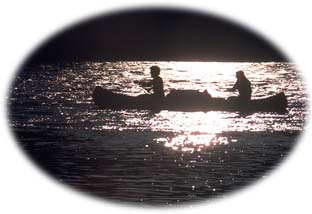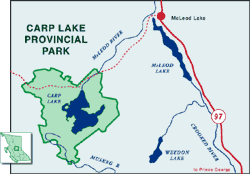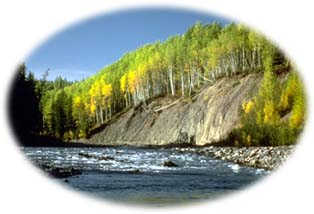|
|
|
|
|
|

The unique landscape of Carp Lake Provincial Park owes its origins to glacial activity in the area. When glaciers scoured this part of the Central Interior Plateau during the last ice age they carved out the basin and determined the outline of Carp Lake and other nearby smaller lakes. The glacial activity also left drumlins (long hills of ground up rock and soil), which established the terrain that became the lakes' many islands and bays. The climate of the area results in short and cool summers, with abundant snow that keeps the park closed during winter months. The isolated nature of 19,344 hectare (47,800 acre) Carp Lake Park makes it an excellent place to get away and relax, while enjoying camping, fishing, short hikes and outstanding canoeing.
|

Carp Lake Park is located close to the geographical center of British Columbia, and is approximately 150 km (90 mi) northwest of Prince George. From Prince George take Highway 97 to the community of McLeod Lake. From there a 32 km (20mi) gravel access road leads into the park. Care must be taken at all times while driving this access road as it is single lane for much of its length and contains many sharp bends. During the spring melt the road may be impassable to cars or vehicles with trailers.

Click on the map to view an enlargement
|
|
"The isolated nature of the...park makes it an excellent place to get away and relax, while enjoying camping, fishing, short hikes and outstanding canoeing."
|

 Carp Lake Provincial Park is of special interest to fishers. Carp Lake itself is renowned for its rainbow trout, while the McLeod River offers sensational fly-fishing. The quality of fish in the Carp Lake area has long been known, and was even noted by the early explorer Simon Fraser in 1806 during his forays through the region. Anglers are encouraged to practice catch and release (especially important since there is no stocking of the lake) and reminded that they must have a valid fishing licence. Carp Lake Provincial Park is of special interest to fishers. Carp Lake itself is renowned for its rainbow trout, while the McLeod River offers sensational fly-fishing. The quality of fish in the Carp Lake area has long been known, and was even noted by the early explorer Simon Fraser in 1806 during his forays through the region. Anglers are encouraged to practice catch and release (especially important since there is no stocking of the lake) and reminded that they must have a valid fishing licence.
In addition to fishing opportunities, Carp Lake Park is also popular for boating, canoeing and camping. There are two vehicle accessible campsites in the park, as well as three boat accessible backcountry campsites on the islands of Carp Lake. Canoeists paddle Carp Lake as well as the 8 km (5 mi) waterway between Carp Lake and War Lake, which is of particular interest.
Boaters can launch from a concrete boat ramp on Carp Lake, or a gravel ramp at War Lake. There are some 20 islands of various sizes within Carp Lake for boaters to explore.
Swimming is best from the two sandy beaches on Carp Lake, both of which can be reached by trails from the campsite. A 3 km (1.9 mi) long interpretative loop trail leads from Carp Lake to Rainbow Lake and the McLeod River. Other trails in the park lead to the double cascade of War Falls.
|
|
"The quality of fish in the Carp Lake area has long been known, and was even noted by the early explorer Simon Fraser in 1806 during his forays through the region."
|

Carp Lake Park is located within the Sub-Boreal Spruce biogeoclimatic zone, which means many areas contain spruce stands while much of the park is forested by aspen and lodgepole pine. Forest around the park's waters tend more towards willow, scrub birch, thimbleberry, and salmonberry.
Wildlife found within the park includes black bears and moose. Moose are most often seen in marsh areas or swimming to and from Carp Lake's many islands. Birds common in the park include loons and other waterfowl, hawks, and whiskey jacks.
The park is best known for its plentiful fish populations. The rainbow trout of Carp Lake are the most familiar, but burbot, northern squawfish, two species of suckers and redside shiners are all found in the park's water.
|
|
"The park is best known for its plentiful fish populations."
|

The earliest recorded use of the Carp Lake area was by the Carrier aboriginal peoples, who frequented the area to take advantage of its abundant fish. The nearest community to Carp Lake Park, Fort McLeod, was established by Simon Fraser in 1805 and was the first European settlement west of the Rockies. In 1806, Fraser noted the importance of Carp Lake's fish, which supplied him and his followers while they stayed at the fort. His journal states that even when the waters of McLeod Lake yielded nothing, Fraser and his companions were able to obtain trout from Carp Lake.
Later, when the fur trade was truly established in the province, a trail ran through what is now Carp Lake Park linking Stuart and McLeod lakes as part of the travel routes used by First Nations. Some portions of this trail remain today, and certain sections have even been incorporated into the park's interpretative loop.
Carp Lake Provincial Park was formally established on May 18, 1973 by the NDP government. At the time a series of parks were brought through to compensate for the loss of Hamber Park. The former Social Credit government had diminished the park system by 740,000 hectares (1,828,614 acres) when they dismantled the Provincial Park in order to allow for damming of the Columbia River. Carp Lake, along with other parks such as Cape Scott and Atlin, was created at the time as a way to compensate for this loss. The area was identified for protection because of its exceptional canoeing lake and glacial remnant features. As a result of the recreational and geographical values of the area, the mid-90s Prince George Land and Resource Management Plan led to Carp Lake Provincial Park being enlarged by 18,000 hectares (44,480 acres) to its current size.
|
|
"The area was identified for protection because of its exceptional canoeing lake and glacial remnant features."
|
|
Return to the Central Interior Region
Become Involved!

|
|

